Freedom Riders
In the 1950s the National Association for the Advancement of Coloured People was involved in the struggle to end segregation on buses and trains. In 1952 segregation on inter-state railways was declared unconstitutional by the Supreme Court. This was followed in 1954 by a similar judgment concerning inter-state buses. However, states in the Deep South continued their own policy of transport segregation. This usually involved whites sitting in the front and blacks sitting nearest to the front had to give up their seats to any whites that were standing. (1)
African American people who disobeyed the state's transport segregation policies were arrested and fined. On 1st December, 1955, Rosa Parks, a middle-aged tailor's assistant from Montgomery, Alabama, who was tired after a hard day's work, refused to give up her seat to a white man. After her arrest, Martin Luther King, a pastor at the local Baptist Church, helped organize protests against bus segregation. It was decided that black people in Montgomery would refuse to use the buses until passengers were completely integrated. King was arrested and his house was fire-bombed. Others involved in the Montgomery Bus Boycott also suffered from harassment and intimidation, but the protest continued. (2)
For thirteen months the 17,000 black people in Montgomery walked to work or obtained lifts from the small car-owning black population of the city. Eventually, the loss of revenue and a decision by the Supreme Court forced the Montgomery Bus Company to accept integration. Martin Luther King toured the country making speeches urging other groups to take up the struggle against segregation, to spread the "Montgomery experience" across the South". (3)
Congress on Racial Equality
Transport segregation continued in the Deep South, so the Congress of Racial Equality (CORE) began to develop strategies to bring it to an end. James Farmer became national director of CORE and in 1960 Genevieve Hughes was appointed as a field secretary. According to Raymond Arsenault: "During the late 1950s she (Hughes) became active in the local chapter of CORE, eventually helping to rejuvenate the chapter by co-ordinating a boycott of dime stores affiliated with chains resisting the sit-in movement in the South. Exhilarated by the boycott and increasingly alienated from the conservative complacency of Wall Street, she gravitated toward a commitment to full-time activism, accepting a CORE field secretary position in the fall of 1960. The first woman to serve on CORE's field staff, she made a lasting impression on everyone who met her." (4) Hughes was once asked why she had joined CORE she replied: "I figured Southern women should be represented to the South and the nation would realize all Southern people don't think alike." (5)
In February, 1961, CORE organised a conference in Kentucky where the organisation laid out its plans to have Freedom Riders challenge the racist policies in the south. It was decided they would ride interstate buses in the South in mixed racial groups to challenge local laws or customs that enforced segregation in seating. (6) John Lewis, a student at Nashville American Baptist Theological Seminary, commented later: "At this time human dignity is the most important thing in my life. This is the most important decision in my life, to decide to give up all if necessary for the Freedom Ride, that Justice and Freedom might come to the Deep South." (7)
Walter Bergman was one of those who volunteered to take part in the Freedom Rides and the training was organised by James Farmer. "Fourteen of us went into training for three days in nonviolent techniques, Gandhi - and Martin Luther King Jr. - type techniques. We had to be absolutely nonviolent, no matter what happened to us. On the last day, the leader, James Farmer, asked, 'Will each of you under all circumstances, no matter what the provocation, refrain from reacting violently?' I was sixty at the time, and it wasn't too difficult for me to say I'd be nonviolent. But there was one young man, a big football player, who said, 'I don't know. If some southern sheriff comes up and tells me that I've got to move along and starts to shove me, I just can't say that I won't shove back.' So James Farmer said, 'Well, we'll have to leave you behind.' That made only thirteen of us, six whites and seven Blacks." (8)
Members of CORE who volunteered to join the Freedom Riders included included John Lewis, James Peck, James Farmer, James Zwerg, James Lawson, Genevieve Hughes, Ed Blankenheim, Frances Bergman, Walter Bergman, Diane Nash, Benjamin Elton Cox, Doris Jean Castle, Salynn McCollum, John Moody, William Barbee, Robert Moses, Marion Barry, Ralph Abernathy, Fred Shuttlesworth, Ella J. Baker, Charles McDew, James Forman, William E. Harbour, Salynn McCollum, Albert Bigelow, Benjamin Elton Cox, Hank Thomas, Susan Wilbur, Susan Herrmann,Bernard Lafayette, Jimmy McDonald, William Sloane Coffin, Jerome Smith, Peter M. Ackerberg, Lucretia R. Collins, John Lee Copeland, Mae Frances Moultrie, Frederick Leonard, Paul Brooks, Catherine Burks, Dion Tyrone Diamond, Grady H. Donald, Frank George Holloway, Wyatt Tee Walker, Charles Butler, Allen Cason, Ernest Patton, Clarence Lloyd Thomas and Leroy Glenn Wright.
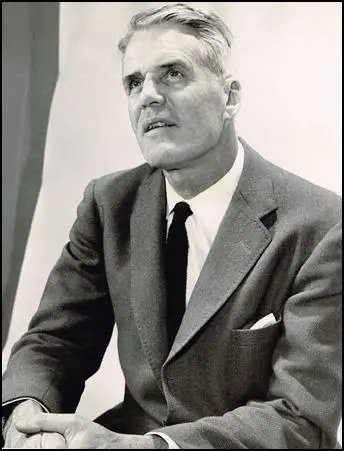
The first bus left Washington on 4th May, 1961, for Georgia, Alabama and Mississippi. Members of CORE who travelled on the bus included John Lewis, James Peck, Ed Blankenheim, Hank Thomas, Walter Bergman, Frances Bergman, Genevieve Hughes, James Farmer, Benjamin Elton Cox, Charles Person and Jimmy McDonald. Farmer later recalled: "We were told that the racists, the segregationists, would go to any extent to hold the line on segregation in interstate travel. So when we began the ride I think all of us were prepared for as much violence as could be thrown at us. We were prepared for the possibility of death." (9)
Diane Nash was one of those young black women rejected to take part in the Freedom Rides. Farmer and his staff tried to come up with a reasonably balanced mixture of black and white, young and old, religious and secular, Northern and Southern. The only deliberate imbalance was a lack of women. The CORE leadership was reluctant to expose women, especially black women, to potentially violent confrontations with white supremacists. "Their decision to limit the number of female Freedom Riders to two was undoubtedly rooted in patriarchal conservatism, but they also feared that a balanced contingent of men and women might be interpreted as a provocative pattern of sexual pairing. The situation was dangerous enough, they reasoned, without taunting the segregationists with visions of interracial sex." (10)
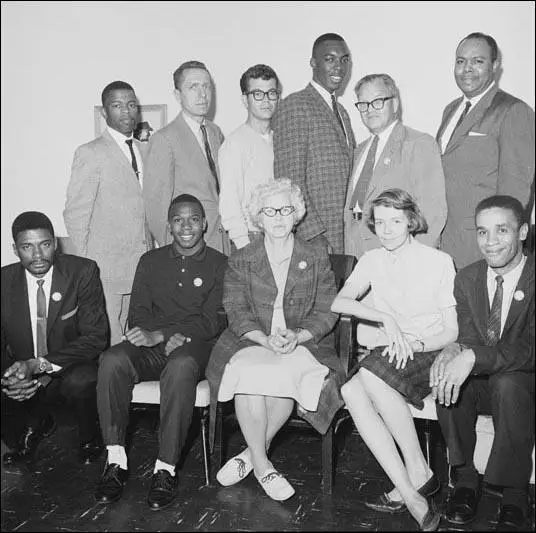
John Lewis, James Peck, Ed Blankenheim, Hank Thomas, Walter Bergman
and James Farmer. Bottom, left to right: Benjamin Elton Cox, Charles Person,
Frances Bergman, Genevieve Hughes and Jimmy McDonald.
The second bus left on the 17th May and its passengers included William Barbee, William E. Harbour, Susan Herrmann, Lafayette Bernard, Susan Wilbur, James Zwerg, Salynn McCollum, Frederick Leonard, Lucretia Collins, Paul Brooks and Catherine Burks, Susan Herrmann, 20, a student at Fisk University, Nashville, majoring in psychology, later recalled: "We were all prepared to die - and for a while Saturday I thought all 21 of us would die at the hands of that mob in Montgomery. We did not fight back. We do not believe in violence. We were freedom riders... trying to ride in buses through Alabama to New Orleans to help the cause of true freedom for all the races." (11)
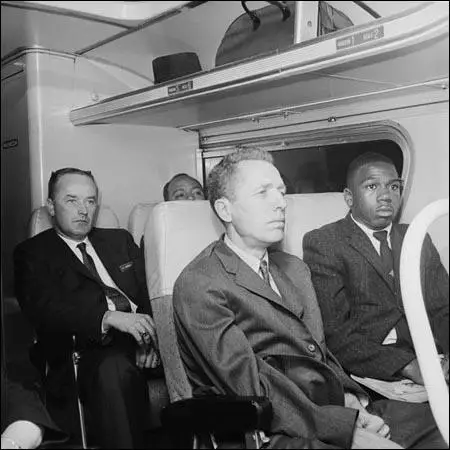
George Lincoln Rockwell, the leader of the American Nazi Party, offered his support to the Ku Klux Klan in their fight against the Freedom Riders. Rockwell secured a Volkswagen van and decorated it with slogans supporting white supremacy, dubbing it the "Hate Bus" and driving it to speaking engagements and party rallies. In one speech Rockwell said: "Anybody that doesn't hate communism and doesn't hate race-mixers, there's something wrong with them." At meetings Nazi Party members carried signs with the words "America for Whites", "Africa for Blacks" and "Gas Chamber for Traitors". (12)
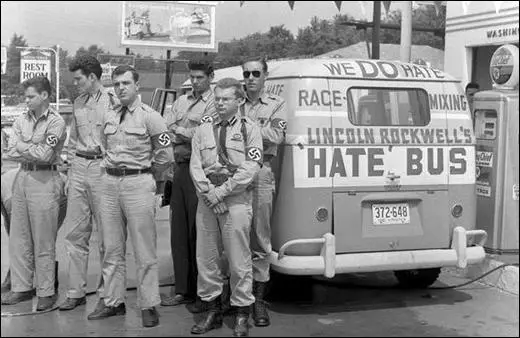
President John F. Kennedy was totally opposed to the Freedom Rides. He called Harris Wofford, the president's Special Assistant for Civil Rights and demanded that he do everything to stop them from taking place: "Kennedy's call to me during the Freedom Rides when he said, without any of his customary humor, 'Stop them! Get your friends off those buses!' He felt that Martin Luther King, James Farmer, Bill Coffin, and company were embarrassing him and the country on the eve of the meeting in Vienna with Khrushchev. He supported every American's right to stand up or sit down for his rights - but not to ride for them in the spring of 1961." (13)
Freedom Riders in Alabama
The Freedom Riders were split between two buses. They traveled in integrated seating and visited "white only" restaurants. Governor John Malcolm Patterson of Alabama who had been swept to victory in 1958 on a stridently white supremacist platform, commented that: "The people of Alabama are so enraged that I cannot guarantee protection for this bunch of rabble-rousers." Patterson, who had been elected with the support of the Ku Klux Klan added that integration would come to Alabama only "over my dead body." (14) In his inaugural address Patterson declared: "I will oppose with every ounce of energy I possess and will use every power at my command to prevent any mixing of white and Negro races in the classrooms of this state." (15)
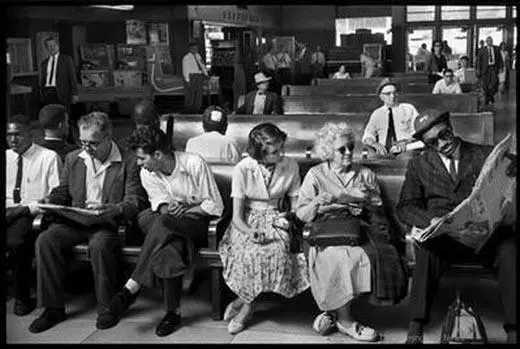
Frances Bergman and Benjamin Elton Cox in a white waiting-room (May, 1961)
The Birmingham, Police Commissioner, Bull Connor, organized violence against the Freedom Riders with local Ku Klux Klan groups. Gary Thomas Rowe, an FBI informer, and a member of the KKK, reported to his case officer that the mob would have fifteen minutes to attack the Freedom Riders without any arrests being made. Connor said he wanted the Riders to be beaten until "it looked like a bulldog got a hold of them." It was later revealed that J. Edgar Hoover knew the plans for the attack on the Freedom Riders in advance and took no action to prevent the violence. (16)
James Peck later explained: "When the Greyhound bus pulled into Anniston, it was immediately surrounded by an angry mob armed with iron bars. They set about the vehicle, denting the sides, breaking windows, and slashing tires. Finally, the police arrived and the bus managed to depart. But the mob pursued in cars. Within minutes, the pursuing mob was hitting the bus with iron bars. The rear window was broken and a bomb was hurled inside. All the passengers managed to escape before the bus burst into flames and was totally destroyed. Policemen, who had been standing by, belatedly came on the scene. A couple of them fired into the air. The mob dispersed and the injured were taken to a local hospital." (17)
Albert Bigelow later told a committee of inquiry: "Our bus, approaching Anniston, stopped while our driver conversed with the driver of an outgoing bus. A traveler from the bus leaving Anniston station. Outside, no police were in sight. During the fifteen minutes in Anniston, while the mob slashed tires and smashed windows, one policeman appeared in a brown uniform. He did nothing to stop vandalism but fraternized with the mob. A man in a white overall with a dark blue oval insignia on the breast was friendly with the policemen and consulted from time to time with the most active of the mob. Two policemen appeared and cleared a path. The bus left the station. There were no arrests. A few miles out on the highway to Birmingham a tire blow and we pulled to the roadside, the mob after us in about 50 cars. They surrounded us again, yelling and smashing windows, brandishing clubs, chains and pipes; I saw all three." (18)
Some, having just come from church, were dressed in their Sunday best. Ed Blankenheim later recalled: "As a matter of fact, one of the white men who boarded the bus said, 'Y'all ain't in Georgia now, y'all in Alabama.' And with that, he eventually set the bus on fire which was not a good place to be at the time. They held the door shut for maybe ten minutes, they held the door shut... The mob surrounded the bus. The cops would not let the mob get on the bus. So they threw an incendiary device aboard... They were mighty angry people. Really, really vicious. They, as I said, they did surround the bus. They threw a fire bomb aboard and held the door closed. One of the tanks blew up. One of the gas tanks blew up and Hank Thomas, who was one of the Freedom Riders, took advantage of it and was able to force open the bus door, thereby we got off. When we did get off... we had to run through the... these racists who beat us all like hell. Fortunately, well it didn't sound fortunate, the second fuel tank on the bus exploded, scared the hell out of the mob so they uh went on the other side of the highway and the object was to leave us there where we would be blown up." (19)
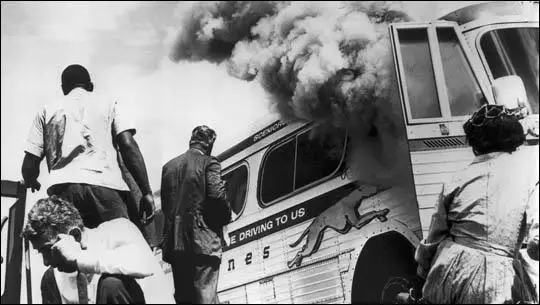
When the Freedom Riders left the bus they were attacked by baseball bats and iron bars. Genevieve Hughes said she would have been killed but an exploding fuel tank convinced the mob that the whole bus was about to explode and the white bomb retreated. Eventually they were rescued by local police but no attempt was made to identify or arrest those responsible for the assault. (20)
Ed Blankenheim pointed out that: "At the very last moment, an ambulance came and took us to the hospital in Anniston Alabama. There the mob surrounded the bus. They gave the hospital administrators one hour, to let us, to get us out into the parking lot to the mob... Genevieve Hughes and I were the first ones hospitalized because we had pretty weak lungs. We found out all of us couldn't be hospitalized because they don't take blacks in Alabama into the hospital. We refused to go to our rooms and went down to the emergency room with the rest of the Freedom Riders." (21)
Genevieve Hughes later recalled that they were taken to the local hospital. "They admitted me into a ward like room not a private room which is what they had in those days and all the black people were kept on gurneys out in in the corridor they were not admitted to the hospital in any formal since nobody had any injuries that I knew of except for smoke inhalation which was fairly serious but more for me because the smoke bomb had been placed in the seat right opposite of mine and I had probably breathed more smoke than anybody else." (22)
Attack in Montgomery
The surviving bus traveled to Birmingham, Alabama. When they arrived at the Montgomery Greyhound Bus Station they saw an angry mob. Gary Thomas Rowe was a member of the KKK who had arrived in the town that day: "We made an astounding sight... men running and walking down the streets of Birmingham on Sunday afternoon carrying chains, sticks, and clubs. Everything was deserted; no police officers were to be seen except one on a street corner. He stepped off and let us go by, and we barged into the bus station and took it over like an army of occupation. There were Klansmen in the waiting room, in the rest rooms, in the parking area." (23)
James Zwerg later recalled: "As we were going from Birmingham to Montgomery, we'd look out the windows and we were kind of overwhelmed with the show of force - police cars with sub-machine guns attached to the backseats, planes going overhead... We had a real entourage accompanying us. Then, as we hit the city limits, it all just disappeared. As we pulled into the bus station a squad car pulled out - a police squad car. The police later said they knew nothing about our coming, and they did not arrive until after 20 minutes of beatings had taken place. Later we discovered that the instigator of the violence was a police sergeant who took a day off and was a member of the Klan. They knew we were coming. It was a set-up." (24)
The driver had a brief conversation with the white mob. He returned to the bus with a small group of white people and told the passengers: "We have received word that a bus has been burned to the ground and passengers are being carried to the hospital by the carloads. A mob is waiting for our bus and will do the same to us unless we get these blacks off the front seats." The white men began to try and remove Charles Person and Herman K. Harris from the front seat. Walter Bergman and James Peck attempted to intervene but they were soon knocked to the floor. (25)
Harris later testified that there were "two main guys" kicking Bergman, and that they "just kicked him and kicked, just kicked him... his head and shoulders in the back. I thought maybe they would break his, bust his head." The men adhered to Gandhian discipline and refused to fight back and all the men took severe beatings, but this only encouraged their attackers. Walter Bergman was knocked unconscious, and one of the attackers continued to stomp on his chest. Frances Bergman begged the Klansman to stop beating her husband, he ignored her plea. Fortunately, one of the other Klansmen - realizing that the defenceless Freedom Rider was about to be killed - eventually called a halt to the beating. (26)
They adhered to Gandhian discipline and refused to fight back and all the men took severe beatings, but this only encouraged their attackers. Walter Bergman, the oldest of the Freedom Riders at sixty-one, was knocked unconscious, and one of the attackers continued to stomp on his chest. Frances Bergman begged the Klansman to stop beating her husband, he ignored her plea. Fortunately, one of the other Klansmen - realizing that the defenceless Freedom Rider was about to be killed - eventually called a halt to the beating. (27)
During the Freedom Riders campaign the Attorney General Robert Kennedy telephoned Jim Eastland “seven or eight or twelve times each day, about what was going to happen when they got to Mississippi and what needed to be done. That was finally decided was that there wouldn’t be any violence: as they came over the border, they’d lock them all up.” (28)
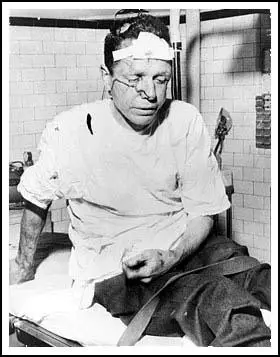
Genevieve Hughes later recalled that it was was James Peck who insisted they continued on the Freedom Ride. "The central figure was Jim Peck and Jim Peck looked like a mummy his head and face were covered with bandages and only his eyes were obvious and his mouth couldn't move and we did have a debate at this occasion about whether to go on. Jim Farmer was not with us. He was back home taking care of a family situation (his father had a serious heart-attack). Jim Peck said we should go on and after that there was not any debate if he couldn't be beaten as he was and still say we should go on we certainly felt we could go on so we all voted unanimously that we would go on and I felt very appalled at seeing Jim Peck but I felt a lot of admiration for him too." (29)
Robert Kennedy and the Freedom Riders
Several years later, government officials would freely acknowledge the heroism and sacrifices of the Freedom Riders but that was not true of 1961. Attorney General Robert Kennedy criticizing the activities of the Freedom Riders as he was worried that support for CORE would hurt the Democratic Party in the Deep South in the 1962 elections. James Farmer was unconvinced by this argument and pointed out that his organization was committed to Gandhian action: "Our philosophy was simple. We put on pressure and create a crisis and then they react." (30)
Robert Kennedy was a close friend of Governor John Patterson of Alabama. Kennedy explained in his interview with Anthony Lewis in 1964. “I had this long relationship with John Patterson (the governor of Alabama). He was our great pal in the South. So he was doubly exercised at me – who was his friend and pal – to have involved him with suddenly surrounding this church with marshals and having marshals descend with no authority, he felt, on his cities… He couldn’t understand why the Kennedys were doing this to him.” (31)
The Attorney General sent John Seigenthaler to negotiate with Governor Patterson of Alabama. Patterson told Seigenthaler that he was more popular than President John F. Kennedy and vowed to hold the line "against Martin Luther King and these rabble-rousers". He added "I want you to know that if schools in Alabama are integrated, blood's gonna flow in the streets, and you take the message back to the President and you tell the Attorney General that." (32)
Harris Wofford, the president's Special Assistant for Civil Rights, later pointed out: "Seigenthaler arrived in time to escort the first group of wounded and shaken riders from the bus terminal to the airport, and flew with them to safety in New Orleans. He had to hurry back, for James Farmer was arriving at the Alabama border with a new group, joined by a contingent from Nashville, including student sit-in leaders James Lawson, John Lewis, and Diane Nash; Lawson, who had studied with Gandhi during three years as a student missionary in India, said they would go by bus all the way to New Orleans, by way of Alabama and Mississippi, or die trying." (33) Seigenthaler called Nash and tried to persuade her to call off the ride. “I’m saying, You’re going to get somebody killed." She replied, "You don’t understand, we signed our wills last night." (34)
Montgomery Bus Terminal Riot
The Birmingham, Police Commissioner, Bull Connor, ordered the arrest of all the Freedom Riders when they arrived in the city. As the only white female, Salynn McCollum was placed in a special facility, and Collins and Burks were put in a cell with several other black women. All the men ended up in a dark and crowded cell that Lewis likened to a dungeon. "It had no mattresses or beds, nothing to sit on at all, just a concrete floor." Harbour and his cellmates adopted a strategy of Gandhian non-cooperation. Lewis added "We went on singing both to keep our spirits up and - to be honest - because we knew that neither Bull Conner nor his guards could stand it." (35)
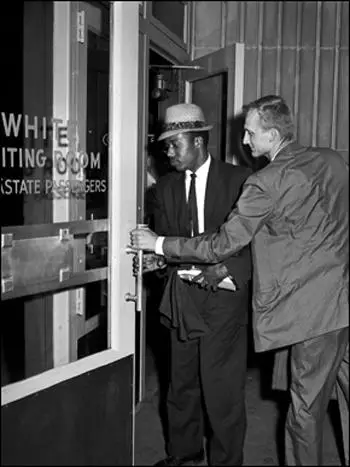
William Pritchard, one of Birmingham's leading attorneys, claimed: "I have no doubt that the Negro basically knows that the best friend he's ever had in the world is the Southern white man. He'd do the most for him - always has and will continue to do it, but when they, from Northern agitators, are spurred on to believe that they are the equal to the white man in every respect and should be just taken from savagery, and put on the same plane with the white man in every respect, that's not true. He shouldn't be... Even the dumbest farmer in the world knows that if he has white chickens and black chickens, that the black chickens do better if they're kept in one yard to themselves." (36)
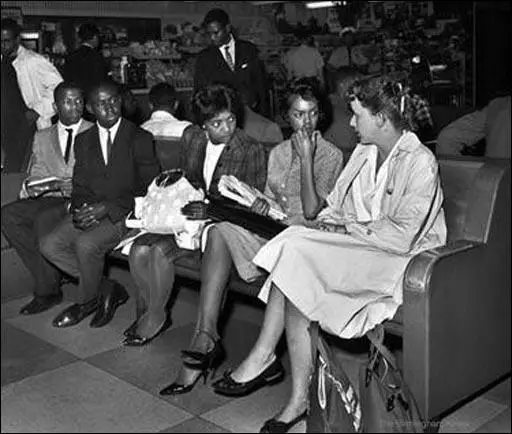
and Salynn McCollum on 17th May, 1961.
Bull Connor announced that he was tired of listening to freedom songs and ordered the students to be taken back to Nashville. Salynn McCollum was released into her father's custody, was already on her wayback to New York. Walter McCollum told reporters: "I sent her to Nashville to get an education, not to get mixed up in this integration." Connor took them to the border town of Ardmore, Alabama, and advised them to take a train or bus back to Nashville. (37)
However, William E. Harbour, John Lewis, James Zwerg, William Barbee, Catherine Burks, and others returned to Montgomery Bus Station. They were also joined by other Freedom Fighters including Susan Wilbur, Susan Herrmann, Bernard Lafayette, Paul Brooks, Allen Cason and Frederick Leonard. The Riders were prepared to spend the night at the terminal. Lewis commented: "We could see them through the glass doors and streetside windows, gesturing at us and shouting. Every now and then a rock or a brick would crash through one of the windows near the ceiling. The police brought in dogs and we could see them outside, pulling at their leashes to keep the crowd back." (38)
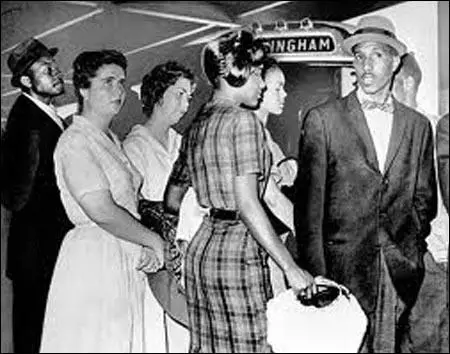
and Bernard Lafayette at the Birmingham Greyhound bus station on May 19th, 1961.
A group of white men armed with lead pipes and baseball bats. Lewis later recalled: "Out of nowhere, from every direction, came people. White people. Men, women, and children. Dozens of them. Hundreds of them. Out of alleys, out of side seats, around the corners of office buildings, they emerged from everywhere, from all directions, all at once, as if they had been let out of a gate... They carried every makeshift weapon imaginable. Baseball bats, wooden boards, bricks, chains, tire irons, pipes, even garden tools - hoes and rakes. One group had woman in front, their faces twisted in anger, screaming." (39)
James Zwerg also received a terrible beating. Frederick Leonard commented that as Zwerg was a white man he was a particular target for their anger. "It was like those people in the mob were possessed. They couldn't believe that there was a white man who would help us... It's like they didn't see the rest of us for about thirty seconds. They didn't see us at all." (40) Klansmen kicked Zwerg in the back before smashing him in the head with his own suitcase. Lucretia R. Collins recalled: "Some men held him while white women clawed his face with their nails. And they held up their little children - children who couldn't have been more than a couple of years old - to claw his face. I had to turn my head because I just couldn't watch it." (41)
Susan Herrmann later recalled: "The mob kept closing in and starting yelling 'Get 'em! Get 'em!'. They picked up Jim Zwerg of Beloit College in Wisconsin, the only white boy in our group, and threw him on the ground. They kicked him unconscious. Still, we didn't fight back. But we didn't believe in running either. I saw some men hold boys, who were nearly unconscious, while white women hit them with purses. The white women were yelling 'Kill them!' and other nasty shouts. The police came and said they would put us in protective custody. They acted like we were crazy. They just couldn't understand why we would be freedom riders. But even though they did not believe in what we were doing, they did protect us and in that sense upheld the law." (42)
John Lewis had been felled by a blow from a wooden Coco-Cola crate and was laying unconscious on the ground. James Zwerg and William Barbee, were also on the ground. Barbee was being stomped and kicked by a taunting swarm of rioters who were shouting, ‘Kill him! Kill him!’ The lives of Zwerg, Lewis and Barbee, were all saved by Floyd Mann the Director of the Alabama Department of Public Safety. "I received some confidential information that when they arrived at the bus station in Montgomery that the police had planned to take a holiday, there'd be no one present." Mann arrived to find the mob trying to kill the Freedom Riders: "Those freedom riders, some of them were being beaten with baseball bats... I just put my pistol to the head of one or two of those folks who was using baseball bats and told them unless they stopped immediately, they was going to be hurt. And it did stop immediately." (43)
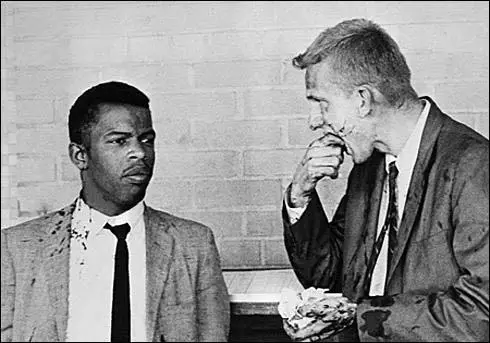
Zwerg removes teeth knocked out by his attackers
Attempts were made by journalists sent by newspapers from national newspapers to cover the Freedom Riders, to get the men to hospital. Police Commissioner L. B. Sullivan told inquiring reporters that all the ambulances for whites were out of service with breakdowns. Zwerg was put into the backseat of a white cab, which was promptly abandoned by the driver. An African-American taxi driver volunteered to take Lewis and Barbee to a hospital, but the segregation laws forced Zwerg to remain behind. Eventually, the police allowed Zwerg to be taken by a black ambulance to a Catholic hospital, which agreed to receive him. (44)
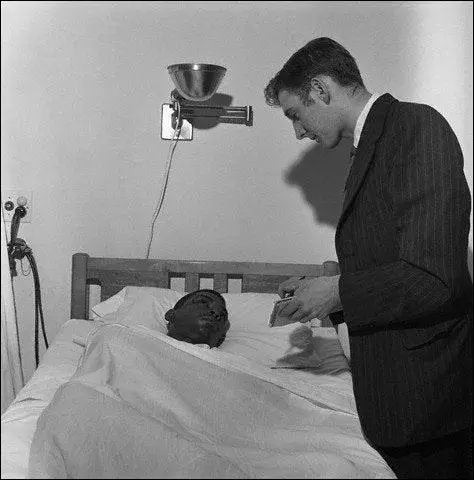
The women Freedom Riders ran for safety. The women approached an African-American taxicab driver and asked him to take them to the First Baptist Church. However, he was unwilling to violate Jim Crow restrictions by taking any white women. He agreed to take the five African-Americans, but the two white women, Susan Wilbur and Susan Herrmann, were left on the curb. They were now attacked by the white mob. (45)
John Seigenthaler, who had been sent by Attorney General Robert Kennedy to negotiate with Governor John Patterson of Alabama, tried to drive into the mob to save a young woman who was being attacked, According to Raymond Arsenault, the author of Freedom Riders (2006): "Suddenly, two rough-looking men dressed in overalls blocked his path to the car door, demanding to know who the hell he was. Seigenthaler replied that he was a federal agent and that they had better not challenge his authority. Before he could say any more, a third man struck him in the back of the head with a pipe. Unconscious, he fell to the pavement, where he was kicked in the ribs by other members of the mob." (46) The crowd "kicked his unconscious body halfway under the car." (47)
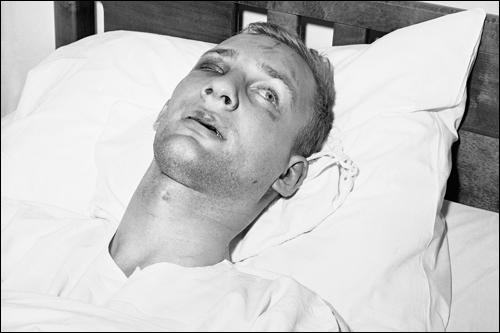
Robert Kennedy, called for a “cooling-off” period and a halt to the rides. The Freedom Riders refused to do this. Speaking from his hospital bed, James Zwerg, assured reporters that "these beatings cannot deter us from our purpose. We are not martyrs or publicity-seekers. We want only equality and justice, and we will get it. We will continue our journey one way or another. We are prepared to die." (48) William Barbee echoed Zwerg's pledge: "As soon as we're recovered from this, we'll start again... We'll take all the South has to throw and still come back for more." Unfortunately, Barbee was unable to do this as a result of the beating he received he was paralyzed for life and had an early death, (49)
According to Ann Bausum: "Zwerg was denied prompt medical attention at the end of the riot on the pretext that no white ambulances were available for transport. He remained unconscious in a Montgomery hospital for two-and-a-half days after the beating and stayed hospitalized for a total of five days. Only later did doctors diagnose that his injuries included a broken back." (50)
James Zwerg later commented: "There was noting particularly heroic in what I did. If you want to talk about heroism, consider the black man who probably saved my life. This man in coveralls, just off of work, happened to walk by as my beating was going on and said 'Stop beating that kid. If you want to beat someone, beat me.' And they did. He was still unconscious when I left the hospital. I don't know if he lived or died." (51)
Mass Arrests in Mississippi
Martin Luther King arrived in Montgomery to give his support to those Freedom Riders. Fred Shuttlesworth and other Civil Rights campaigners, joined John Lewis, Diane Nash, Wyatt Tee Walker who were fit enough to carry on with the ride into the Deep South. Governor Patterson branded the Freedom Riders as "outlaws" and they were forced to take refuge in Montgomery's First Baptist Church. King telephoned the Attorney General to complain about the situation and was not very pleased when he replied: "Now, Reverend, don't tell me that. You know just as well as I do that if it hadn't been for the United States marshals, you'd be dead as Kelsey's nuts right now!" (52)
However, with his attempts to please racist Democratic politicians in the Deep South, he came under attack from the liberal press in the North. For example, The New York Times published an editorial that said: "The issue in Montgomery is the right of American citizens, white and Negro alike, to travel in safety in interstate commerce, without being tested by the so-called Freedom Riders, a racially mixed group consisting primarily of students, who are waging their campaign for civil rights in the South in a Gandhian sprit of idealism and of non-violent resistance to an evil tradition." (53)
The Freedom Riders intended to move their protest to Mississippi. President John F. Kennedy made one last attempt to stop this happening and telephoned Martin Luther King to call-off the action and persuade them to post bonds so that they could leave prison. King replied: "It's a matter of conscience and morality. They must use their lives and bodies to right a wrong. Our conscience tells us that the law is wrong and we must resist, but we have a moral obligation to accept the penalty." Kennedy insisted: "That is not going to have the slightest effect on what the government is going to do in this field or any other. The fact that they stay in jail is not going to have the slightest effect on me." (54)
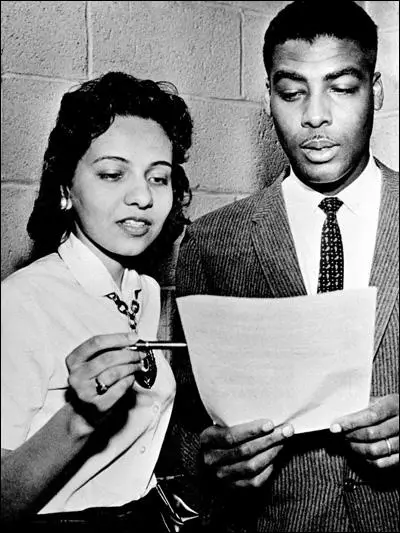
The media was to play an important role in changing the attitudes of the Kennedy administration. On the first bus that left Montgomery for Jackson, Mississippi, on 24th May, 1961, the 12 Freedom Riders led by James Lawson, were joined by members of the National Guard and several journalists. The second bus the Freedom Riders were led by John Lewis and the third bus by the Baptist minister, John Lee Copeland. The following day the fourth bus left Montgomery. Those on board included three Baptist ministers, Ralph Abernathy, Fred Shuttlesworth, Wyatt Tee Walker and William Sloane Coffin, chaplain of Yale University. (55)
On 24th May, 1961, Ed Blankenheim joined with James Farmer, John Lewis, Doris Jean Castle, John Moody, Jerome Smith, Peter M. Ackerberg, Lucretia R. Collins, John Lee Copeland, Dion Tyrone Diamond, Grady H. Donald, Frank George Holloway, Ernest Patton, Hank Thomas, Clarence Lloyd Thomas and Leroy Glenn Wright traveled from Montgomery, Alabama, to Jackson, Mississippi. (56) Castle told Keith Weldon Medley: “Those on the bus with us were a group of people who had never been in each other’s company, bonded by a common goal. Our only weapon was that we were right in what we were doing.” (57)
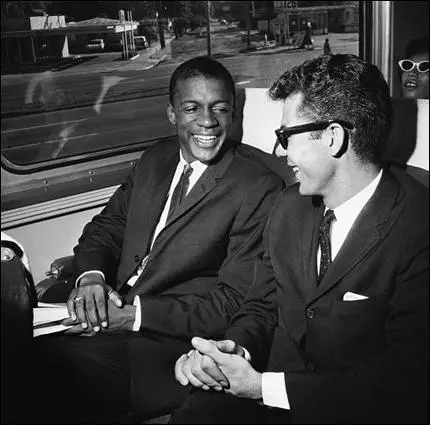
When the buses arrived at the Jackson Terminal, the Freedom Riders, black and white, went into the white waiting room. Several also used the white rest-room. They were immediately arrested. They refused an offer by NAACP attorneys to post a thousand-dollar bond for each defendant. When the Baptist minister, Ralph Abernathy was asked about Robert Kennedy's complaint that the Freedom Riders were embarrassing the nation in front of the world, he responded: "Well doesn't the Attorney General know we've been embarrassed all our lives?" (58)
John Moody wrote to his parents: "I suppose you have been reading the papers and you know what I am doing in Jackson, Mississippi... The trial was yesterday... We are now in cells, 6 to a cell the white fellows being in a cell on the end. We sing and sing and make up songs. We exercise and pray and read appropriate verses from the Bible. We almost has a little trouble this morning. One of the officers here cursed C. T. Vivian, who is a minister from Nashville, Tennessee, after he asked him to explain an order to 'behave'. Imagine, telling grown people to behave - what does that mean? Does it mean not to talk loudly, not to sing or not to count as we do?" (59)
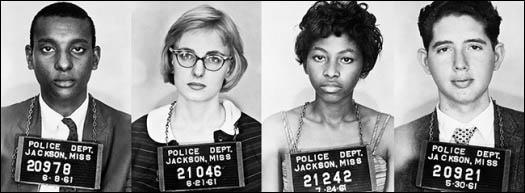
During the summer of 1961 Freedom Riders also campaigned against other forms of racial discrimination. They sat together, in segregated restaurants, lunch counters and hotels. This was especially effective when it concerned large companies who, fearing boycotts in the North, began to desegregate their businesses. Norman Thomas described these young people as "secular saints" (60) I. F. Stone argued: "They and a few white sympathizers as youthful and devoted as themselves have begun a social revolution in the South with their sit-ins and their Freedom Rides. Never has a tinier minority done more for the liberation of a whole people than these few youngsters of C.O.R.E. (Congress for Racial Equality) and S.N.C.C. (Student Non-Violent Coordinating Committee)." (61)
Martin Luther King claimed that he "hundred of thousands" of students willing to travel to the Deep South to join the protests. The administration decided it had to take action. Robert Kennedy now petitioned the Interstate Commerce Commission (ICC) to draft regulations to end racial segregation in bus terminals. The ICC was reluctant but in September 1961 it issued the necessary orders and it went into effect on 1st November. However, James Lawson, one of the Freedom Riders, argued: "We must recognize that we are merely in the prelude to revolution, the beginning, not the end, not even the middle. I do not wish to minimize the gains we have made thus far. But it would be well to recognize that we have been receiving concessions, not real changes. The sit-ins won concessions, not structural changes; the Freedom Rides won great concessions, but not real change." (62)
The FBI and the Freedom Riders
Walter Bergman suffered a severe stroke 10 days after the beating he received in May 1961. He retained most of his speech, but had to learn to write and feed himself again. He never regained the ability to walk and used a wheelchair for the rest of his life. In 1975, Gary Thomas Rowe, an undercover informer for the FBI who joined the Ku Klux Klan, testified before the Senate Intelligence Committee that he had told the agency about the planned attack on the Freedom Riders but that the agency had done nothing to stop it. Rowe's testimony prompted Bergman and his wife to sue the FBI. However, Frances Bergman died in 1979. (63)
Playboy Magazine acquired a confidential 1979 Justice Department 302-page report on Rowe that confirmed that the FBI knew the plans for the attack on the Freedom Riders in advance and did nothing to protect them. Nor did he tell Attorney General Robert Kennedy about this information. The Justice Department stated: "it is indeed unfortunate that the bureau did not take additional action to prevent violence, such as notifying the Attorney General and the United States Marshals Service, who might have been able to do something." (64)
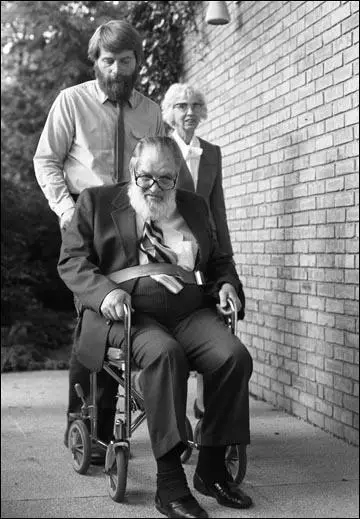
This report enabled Freedom Riders to sue the FBI. In 1983, Judge Charles E. Stewart Jr. of Federal District Court in Manhattan ordered the Government to pay $25,000 to James Peck, one of the Freedom Riders who had been badly beaten in Birmingham. (65) Later that year Bergman was awarded $35,000. The estate of Frances Bergman was awarded $15,000. All proceeds were donated to the American Civil Liberties Union. ''The suit righted the essential history of the period,'' said Howard L. Simon, who was executive director of the American Civil Liberties Union in Michigan when the suit was tried. ''It proved the Federal Government was not an ally of the civil rights worker, but in fact was in league with local law enforcement and the K.K.K.'' (66)
Primary Sources
(1) I. F. Stone, I. F. Stone's Weekly (4th June, 1962)
They and a few white sympathizers as youthful and devoted as themselves have begun a social revolution in the South with their sit-ins and their Freedom Rides. Never has a tinier minority done more for the liberation of a whole people than these few youngsters of C.O.R.E. (Congress for Racial Equality) and S.N.C.C. (Student Non-Violent Coordinating Committee).
(2) James Peck, a member of the Freedom Rides, wrote about his experiences in Alabama on 14th May, 1961, in his book, Freedom Rider (1962)
When the Greyhound bus pulled into Anniston, it was immediately surrounded by an angry mob armed with iron bars. They set about the vehicle, denting the sides, breaking windows, and slashing tires. Finally, the police arrived and the bus managed to depart. But the mob pursued in cars. Within minutes, the pursuing mob was hitting the bus with iron bars. The rear window was broken and a bomb was hurled inside. All the passengers managed to escape before the bus burst into flames and was totally destroyed. Policemen, who had been standing by, belatedly came on the scene. A couple of them fired into the air. The mob dispersed and the injured were taken to a local hospital.
(3) Frederick Leonard was an African American traveling on a Freedom Rides bus that was stopped by a white mob in Montgomery, Alabama.
Jim Zwerg was a white fellow from Madison, Wisconsin. He had a lot of nerve. I think that is what saved me because Jim Zwerg walked off the bus in front of us. The crowd was possessed. They couldn't believe that there was a white man who would help us. They grabbed him and pulled him into the mob. Their attention was on him. It was as if they didn't see us.
(4) James Zwerg was badly injured and left in the road for over an hour. White ambulances refused to take him to hospital. Afterwards he was interviewed in hospital by reporters.
Segregation must be stopped. It must be broken down. Those of us on the Freedom Ride will continue. No matter what happens we are dedicated to this. We will take the beatings. We are willing to accept death. We are going to keep coming until we can ride anywhere in the South.
(5) James Farmer was the director of the Congress on Racial Equality and was the main organizer of the Freedom Rides. In Plaquemine, Louisiana, Farmer was surrounded by a white mob who claimed they intended to lynch him.
I was certain I was going to die. What kind of death would it be? Would they mutilate me first? What does it feel like to die? Then I grew panicky about the insurance. Had I paid the last installment? My wife and little girls - how would it be for them? Well, damn it, if I had to die, at least let the organization wring some use out of my death. I hoped the newspapers were out there. Plenty of them. With plenty of cameras.
(6) William Mahoney, a student at Howard University, was a freedom rider and was eventually arrested in Jackson, Mississippi, and was imprisoned in Parchman Penitentiary. He wrote about his experiences for Liberation Magazine.
At our first stop in Virginia I was confronted with what the Southern white has called "separate but equal." A modern rest station with gleaming counters and picture windows was labeled"White," and a small wooden shack beside it was tagged "Colored." The colored waiting room was filthy, in need of repair, and overcrowded. When we entered the white waiting room Frank Hunt was promptly but courteously, in the Southern manner, asked to leave. Because I am a fair-skinned Negro I was waited upon. I walked back to the bus through the cool night trembling and perspiring.
The Montgomery bus station was surrounded by Army jeeps, trucks, and the National Guard in battle gear. We found the people from the Christian Leadership Council who had been sent to meet us and drove away cautiously, realizing that the least traffic violation would be an excuse for our arrest.
Once across the (Mississippi) state line we passed a couple of police cars, which began to follow us. At our first stop the station was cordoned off a block in every direction. A police officer jumped on the bus and forbade anyone to move. One woman, who was a regular passenger, frantically tried to convince the police that she was not involved with us. After checking her ticket the police let her get off.
As we rolled toward Jackson, every blocked-off street, every back road taken, every change in speed caused our hearts to leap. Our arrival and speedy arrest in the white bus station in Jackson, when we refused to obey a policeman's order to move on, was a relief.
(7) James Farmer, interviewed by Howell Raines for his book, My Soul is Rested: Movement Days in the Deep South Remembered (1983)
I was impressed by the fact that most of the activity thus far had been of local people working on their local problems-- Greensborans sitting-in in Greensboro and Atlantans sitting-in in Atlanta - and the pressure of the opposition against having outsiders come was very, very great. If any outsiders came in... "Get that outside agitator." . . . I thought that this was going to limit the growth of the Movement.... We somehow had to cut across states lines and establish the position that we were entitled to act any place in the country, no matter where we hung our hat and called home, because it was our country.
We also felt that one of the weaknesses of the student sit-in movement of the South had been that as soon as arrested, the kids bailed out... This was not quite Gandhian and not the best tactic. A better tactic would be to remain in jail and to make the maintenance of segregation so expensive for the state and the city that they would hopefully come to the conclusion that they could no longer afford it. Fill up the jails, as Gandhi did in India, fill them to bursting if we had to. In other words, stay in without bail.
So those were the two things: cutting across state lines, putting the movement on wheels, so to speak, and remaining in jail, not only for its publicity value but for the financial pressure it would put upon the segregators. We decided that a good approach here would be to move away from restaurant lunch counters. That had been the Southern student sit-in movement, and anything we would do on that would be anticlimactic now. We would have to move into another area and so we decided to move into the transportation, interstate transportation...
So we, following the Gandhian technique, wrote to Washington. We wrote to the Justice Department, to the FBI, and to the President, and wrote to Greyhound Bus Company and Trailways Bus Company, and told them that on May first or May fourth - whatever the date was, I forget now - we were going to have a Freedom Ride. Blacks and whites were going to leave Washington, D.C., on Greyhound and Trailways, deliberately violating the segregated seating requirements and at each rest stop would violate the segregated use of facilities. And we would be nonviolent, absolutely nonviolent, throughout the campaign, and we would accept the consequences of our actions. This was a deliberate act of civil disobedience...
We got no reply from Justice. Bobby Kennedy (U.S. Attorney General) no reply. We got no reply from the FBI. We got no reply from the White House, from President Kennedy. We got no reply from Greyhound or Trailways. We got no replies...
We had some of the group of thirteen sit at a simulated counter asking for coffee. Somebody else refused them service, and then we'd have others come in as white hoodlums to beat 'em up and knock them off the counter and club 'em around and kick 'em in the ribs and stomp 'em, and they were quite realistic, I must say. I thought they bent over backwards to be realistic. I was aching all over. And then we'd go into a discussion as to how the roles were played, whether there was something that the Freedom Riders did that they shouldn't have done, said that they shouldn't have said, something that they didn't say or do that they should have, and so on. Then we'd reverse roles and play it over and over again and have lengthy discussions of it.
I felt, by the way, that by the time that group left Washington, they were prepared for anything, even death, and this was a possibility, and we knew it, when we got to the Deep South.
Through Virginia we had no problem. In fact they had heard we were coming, Greyhound and Trailways, and they had taken down the For Colored and For Whites signs, and we rode right through. Yep. The same was true in North Carolina. Signs had come down just the previous day, blacks told us. And so the letters in advance did something.
In South Carolina it was a different story.... John Lewis started into a white waiting room in some town in South Carolina... and there were several young white hoodlums, leather jackets, ducktail haircuts, standing there smoking, and they blocked the door and said, "You can't come in here." He said, "I have every right to enter this waiting room according to the Supreme Court of the United States in the Boynton case."
They said, "Shit on that." He tried to walk past, and they clubbed him, beat him, and knocked him down. One of the white Freedom Riders . . . Albert Bigelow, who had been a Navy captain during World War II, big, tall, strapping fellow, very impressive, from Connecticut - then stepped right between the hoodlums and John Lewis. Lewis had been absorbing more of the punishment. They then clubbed Bigelow and finally knocked him down, and that took some knocking because he was a pretty strapping fellow, and he didn't hit back at all. They knocked him down, and at this point police arrived and intervened. They didn't make any arrests. Intervened.
(8) Albert Bigelow, testimony, Committee of Inquiry (25th May, 1962)
Our bus, approaching Anniston, stopped while our driver conversed with the driver of an outgoing bus. A traveler from the bus leaving Anniston station. Outside, no police were in sight. During the fifteen minutes in Anniston, while the mob slashed tires and smashed windows, one policeman appeared in a brown uniform. He did nothing to stop vandalism but fraternized with the mob. A man in a white overall with a dark blue oval insignia on the breast was friendly with the policemen and consulted from time to time with the most active of the mob. Two policemen appeared and cleared a path. The bus left the station. There were no arrests.
A few miles out on the highway to Birmingham a tire blow and we pulled to the roadside, the mob after us in about 50 cars. They surrounded us again, yelling and smashing windows, brandishing clubs, chains and pipes; I saw all three. They surged around the bus, screamed obscenities and tried to board but were prevented by Eli Cowling of the State Highway police, in plainclothes, who with a pistol, held back the mob from inside our door. We had thought Cowling an ordinary passenger. This single-handed action showed that a mob can be held off.
(9) Hank Thomas, interviewed by Howell Raines for his book, My Soul is Rested: Movement Days in the Deep South Remembered (1983)
The Freedom Ride didn't really get rough until we got down in the Deep South. Needless to say, Anniston, Alabama, I'm never gonna forget that, when I was on the bus that they threw some kind of incendiary device on.
I got real scared then. You know, I was thinking - I'm looking out the window there, and people are out there yelling and screaming. They just about broke every window out of the bus... I really thought that that was going to be the end of me.
They shot the tires out, and the bus driver was forced to stop... He got off, and man, he took off like a rabbit, and might well have. I couldn't very well blame him there. And we were trapped on the bus. They tried to board. Well, we did have two FBI men aboard the bus. All they were there to do were to observe and gather facts, but the crowd apparently recognized them as FBI men, and they did not try to hurt them.
It wasn't until the thing was shot on the bus and the bus caught afire that everything got out of control, and... when the bus was burning, I figured... panic did get a hold of me. Needless to say, I couldn't survive that burning bus. There was a possibility I could have survived the mob, but I was just so afraid of the mob that I was going to stay on that bus. I mean, I just got that much afraid. And when we got off the bus... first they closed the doors and wouldn't let us off. But then I'm pretty sure they realized, that somebody said, "Hey, the bus is going to explode," because it had just gassed up, and so they started scattering then, and I guess that's the way we got off the bus. Otherwise, we probably all would have been succumbed by the smoke, and not being able to get off, probably would have been burned alive or burned on there anyway. That's the only time I was really, really afraid. I got whacked over the head with a rock or I think some kind of a stick as I was coming off the bus.
We were taken to the hospital. The bus started exploding, and a lot of people were cut by flying glass. We were taken to the hospital, most of us, for smoke inhalation.... I think I was half out of it, half dazed, as a result of the smoke, and, gosh, I can still smell that stuff down in me now. You got to the point where you started having the dry heaves. Took us to the hospital, and it was incredible. The people at the hospital would not do anything for us. They would not. And I was saying, "You're doctors, you're medical personnel." They wouldn't. Governor Patterson got on statewide radio and said, "Any rioters in this state will not receive police protection." And then the crowd started forming outside the hospital, and the hospital told us to leave. And we said, "No, we're not going out there," and there we were. A caravan from Birmingham, about a fifteen-car caravan led by the Reverend Fred Shuttlesworth, came up from Birmingham to get us out. . . .
Every one of those cars had a shotgun in it. And Fred Shuttlesworth had got on the radio and said--you know Fred, he's very dramatic--"I'm going to get my people." He said, "I'm a nonviolent man, but I'm going to get my people." And apparently a hell of a lot of people believed in him. Man, they came there and they were a welcome sight. And each one of 'em got out with their guns and everything and the state police were there, but I think they all realized that this was not a time to say anything because, I'm pretty sure, there would have been a lot of people killed. . . .
Oh, we did have one girl, Genevieve Hughes, a white girl, who had a busted lip. I remember a nurse applying something to that, but other than that, nothing. Now that I look back on it, man, we had some vicious people down there, wouldn't even so much as treat you. But that's the way it was. But strangely enough, even those bad things then don't stick in my mind that much. Not that I'm full of love and goodwill for everybody in my heart, but I chalk it off to part of the things that I'm going to be able to sit on my front porch in my rocking chair and tell my young'uns about, my grandchildren about.
